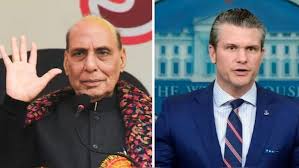India and US to sign defence framework when Rajnath Singh, his American counterpart Pete Hegseth meet next

India and the United States are getting ready to sign a new 10-year defence framework. Defence Minister Rajnath Singh and US Secretary of Defence Pete Hegseth will formalize the deal during their next meeting. The agreement reflects both countries’ intent to deepen military cooperation.
During a phone call on July 1, the two leaders confirmed their plan to finalize the agreement. The Ministry of Defence in India shared details of the discussion soon after the call.
A Roadmap for Strategic Military Growth
This pact will replace the previous 2015 framework. It outlines a long-term vision for stronger defence ties. Unlike earlier agreements, this one focuses on technology sharing, defence exports, and joint production. The US also wants India to play a larger role in its South Asia strategy.
The agreement will help both sides work more closely on joint projects and military operations. India aims to strengthen its defence capabilities while reducing dependency on imports.
Major Focus Areas in the Defence Framework
The new deal will include cooperation in several important areas:
- Co-production and Manufacturing: India and the US will work together to build military platforms like armoured vehicles and fighter jet engines. The recent GE F414 engine deal for India’s Tejas jets is a good example.
- Advanced Weapon Sales: India plans to purchase Javelin missiles, Stryker vehicles, and more P-8I surveillance aircraft.
- Joint Exercises: Both countries will expand military exercises such as Yudh Abhyas and Tiger Triumph.
- Tech Sharing and R&D: They will collaborate on defence technologies, including artificial intelligence and cyber tools.
- Supply Chain Security: Both sides aim to create secure, reliable defence supply chains.
Hegseth’s View on India’s Role
Pete Hegseth called India a “key defence partner in South Asia.” He believes the relationship goes beyond arms sales. Hegseth said, “Our partnership with India is not transactional—it is transformational.” He emphasized the importance of building a future based on trust and cooperation.
Since taking office, Hegseth has actively supported stronger ties with India. His comments show that the US sees India as a long-term ally in defence and regional stability.
Strengthening the Indo-Pacific Strategy
This deal also supports the US-led Indo-Pacific strategy. As part of the QUAD—alongside Japan and Australia—India plays a major role in maintaining peace in the region. The defence framework will include plans for naval cooperation and better intelligence sharing.
India and the US will also explore more logistics agreements to help their navies work better together. Maritime security in the Indian Ocean will be a major focus.
Bipartisan Support for India-US Ties
Leaders in both India and the US have supported the growing defence relationship. In India, the Modi government continues to push for stronger military partnerships with democratic allies. In the US, both Republicans and Democrats back closer ties with India.
This agreement reflects that support. It also shows the growing trust between the two countries. Both governments see the pact as a step toward long-term defence collaboration.
Upcoming Meeting to Seal the Deal
Officials are still finalizing the date and location of the next Rajnath-Hegseth meeting. The two sides are working on the agreement’s text. Defence industry leaders and military officials are also offering input.
Once signed, the deal will guide defence cooperation for the next 10 years. It will set clear goals for production, technology, and regional security efforts.
Conclusion
India and the United States are building a powerful defence partnership. The upcoming 10-year agreement shows their shared goals and values. It will improve joint military efforts and support peace in the Indo-Pacific region.
As both countries face rising global challenges, this defence pact sends a clear message. India and the US are ready to lead together—and defend together.






